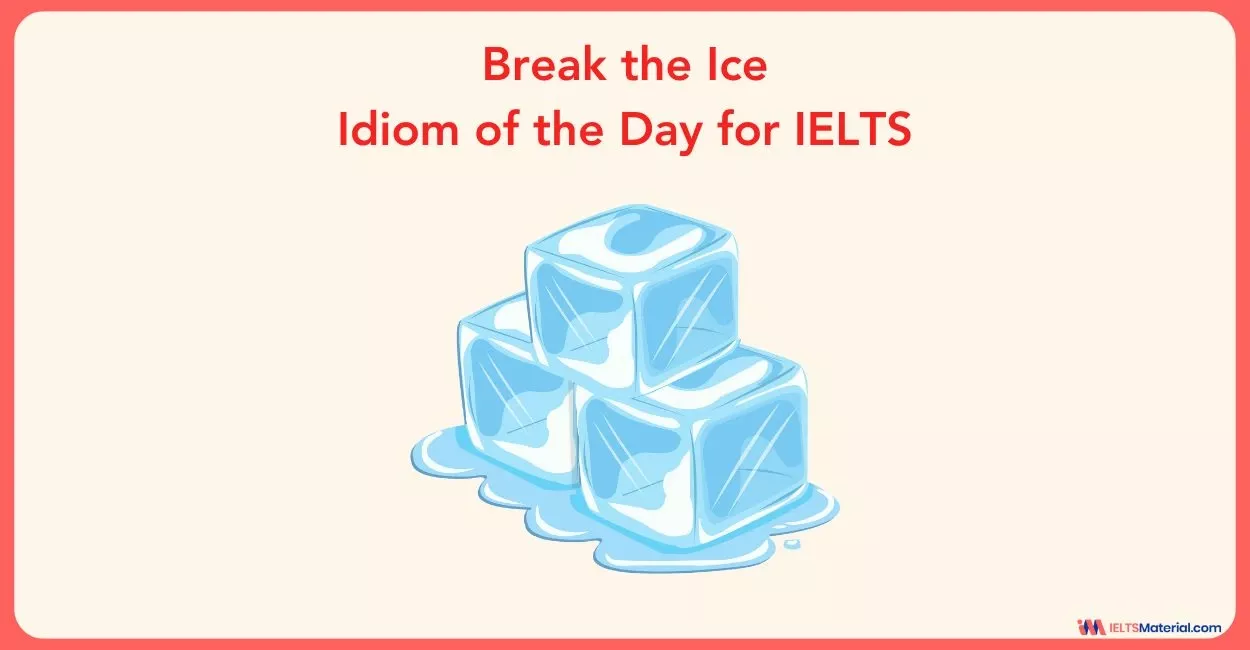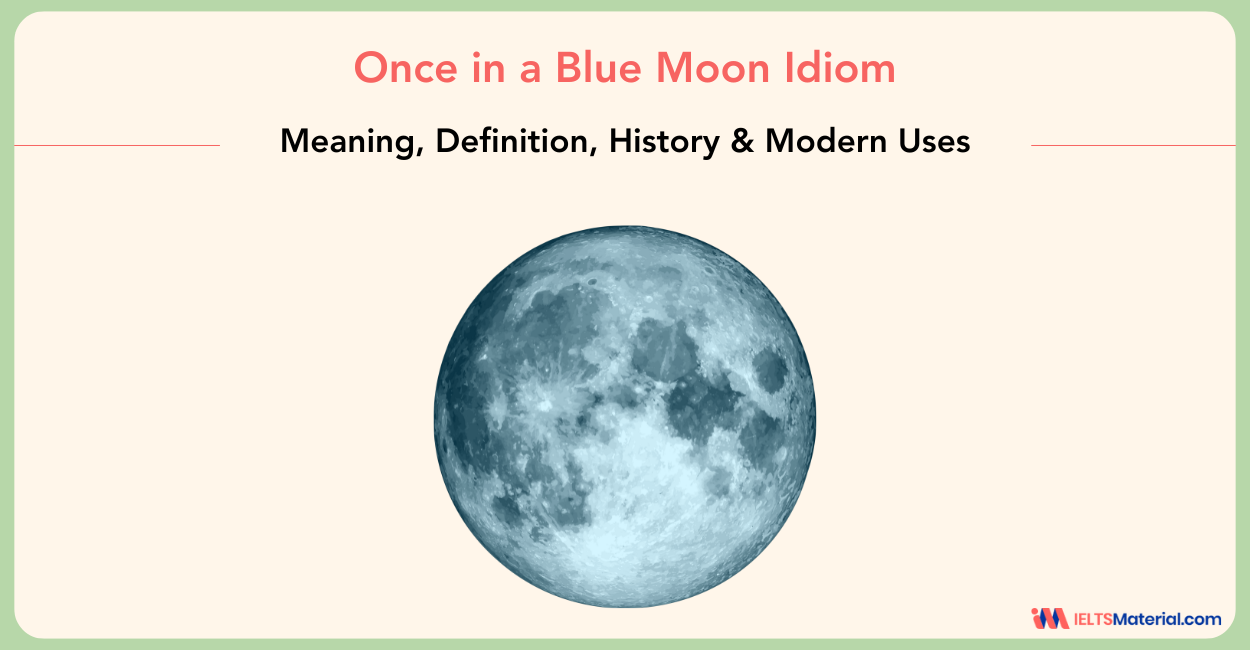Break the Ice - Idiom of the Day for IELTS
5 min read
Updated On
-
Copy link
The idiom 'Break the Ice” means that a person starts a conversation first breaking the silence. You will find out the idiom's origin, examples of its usage in IELTS Speaking and writing in this article to master the correct usage of this idiom!
Table of Contents
- Meaning of the ‘Break the Ice’ IELTS Idiom
- Where Did the Idiom ‘Break the Ice’ Come From?
- Synonyms of the ‘Break the Ice’ Idiom
- Antonyms of the ‘Break the Ice’ Idiom
- Common Mistakes to Avoid While Using the ‘Break the Ice’ Idiom
- A Sample Scenario to Use the Idiom ‘Break the Ice’
- Examples to Understand the Usage of the ‘Break the Ice’ Idiom in Sentences

Limited-Time Offer : Access a FREE 10-Day IELTS Study Plan!
The IELTS idiom “Break the Ice” is apt for responding to questions about your office, college, meetings and much more. This idiom means to begin a conversation in an awkwardly silent situation so that the opposite person also starts talking without feeling shy.
In this article, you will learn how to use “Break the Ice” accurately in your answers, with sample sentences, meanings, and context-based scenarios to boost your IELTS exam’s lexical resource band score.
Meaning of the ‘Break the Ice’ IELTS Idiom
This idiom “break the ice” directly means to initiate conversation or an interaction in any situation where people might feel shy, unfamiliar with each other or even uncomfortable. This refers to the act of reducing tension and then creating a more relaxed atmosphere so that a communication can start.
In the IELTS Speaking or Writing, the idiom is mainly useful since you can use it in the topics related to social gatherings, cultural interactions, teamwork, new starts, or even in classroom interactions.
Trying to say “I tried to break the ice” shows that you as a person can express subtle social interactions in a proper and natural idiomatic way which is something IELTS examiners value highly when they are assessing your fluency and lexical resource score.
For example:
“At the start of the group discussion, since no one was talking, I cracked a casual joke to break the ice.”
Where Did the Idiom ‘Break the Ice’ Come From?
The origin of this phrase dates back to the 16th and 17th centuries, wherein the ships traveling through frozen seas would quite often need to literally “break the ice” so that other passing boats could pass. Over the time, this term then evolved metaphorically to mean removing obstacles in a proper communication or relationships.
The very first figurative use appeared in English literature, where “breaking the ice” meant to start a conversation and to make progress in a relationship. Eventually, this phrase entered into everyday English and it is now widely used in both formal and informal settings in order to describe easing tension in social situations.
This particular historical link makes the idiom very visual since just as ships cannot move forward without breaking the ice, and the conversations often cannot flow without one person making the first move.
Find out more Idioms to stand out from the crowd in your IELTS! Book a Free Demo
Synonyms of the ‘Break the Ice’ Idiom
Here are some of the alternative phrases and expressions you can use instead of “break the ice”:
- Start a conversation
- Initiate an interaction
- Easing the tension
- Making the first move
- Getting things rolling
Using these alternative set of phrases alongside the idiom can also help you avoid repetition in the IELTS Writing and Speaking test and make you expand your vocabulary range.
Antonyms of the ‘Break the Ice’ Idiom
On the opposite end these are the phrases that carry the opposite meaning of “breaking the ice”:
- Creating tension
- An awkward silence
- Increasing discomfort
- Closing off communication
- Making things worse socially
These are some of the antonyms that will also be helpful when discussing challenges in teamwork, cross-cultural communication, or even in social interactions in your IELTS answers.
Common Mistakes to Avoid While Using the ‘Break the Ice’ Idiom
Most of the learners may make mistakes when applying this idiom into use. Here are some of those to watch out for:
- Taking it literally.
Some people mistakenly describe physical ice-breaking activities (For example: skating or even cold weather). Remember, the idiom is metaphorical to use in everyday English.
- Using it in a wrong context
This idiom should only be used in social or conversational situations. You do not “break the ice” when you try to fix a machine or sit to solve a math problem.
- Overusing it
The IELTS examiners look for candidates who make a natural use of the idioms. If you usually repeat the phrase too often, this will sound forced.
- Confusing tense or structure
The perfect form is usually “break the ice” or “broke the ice.” Do not mistakenly say “cut the ice” or “melt the ice.”
If you avoid these mistakes, you will for sure sound much more natural and confident in both the IELTS Speaking and Writing tasks.
Get your hands on this IELTS Vocabulary Ebook to expand your word list for your IELTS test!
A Sample Scenario to Use the Idiom ‘Break the Ice’
If you are asked in the IELTS Speaking Part 2 to describe a time when you met new people. You could answer like this:
“When I joined my new college, the first week was quite uncomfortable since I didn’t know anyone in my classes. Hence, one of our teachers organized a group activity wherein each student had to introduce themselves and share a quick fun fact about them. That simple activity really helped everyone to break the ice, and after that, all the students felt more relaxed and open to talking.”
This is an example that shows the examiner that you can naturally incorporate idiomatic expressions as you are storytelling, which also raises your fluency band score.
Examples to Understand the Usage of the ‘Break the Ice’ Idiom in Sentences
- Our host told a funny story in order to break the ice at the event.
- In business meetings, a small talk is often used to break the ice right before discussing serious matters.
- When my friend started a new job, her colleagues helped break the ice by inviting her to lunch.
- Teachers often use small and funny games in the first class to break the ice among the students.
- My mother always finds that asking questions about hobbies is a good way to break the ice with unfamiliar people.
- We played some funny game to break the ice.
- Jane’s arrival broke the ice and people began to talk and laugh.
- A smile is a powerful weapon to break the ice.
Also Check:
- Once in a Blue Moon Idiom: Meaning, Definition & Synonyms
- Play It By Ear Idiom: Meaning, Origin, Usage & Exercises
- The most Common Idioms to Boost Your IELTS Score - Topic : Help and encouragement
Explore IELTS Resources

Start Preparing for IELTS: Get Your 10-Day Study Plan Today!
Recent Articles

Kasturika Samanta

Prity Mallick

Nehasri Ravishenbagam





Post your Comments